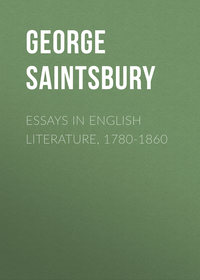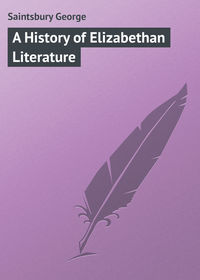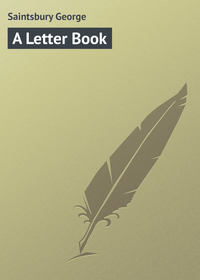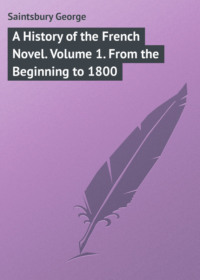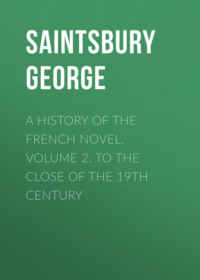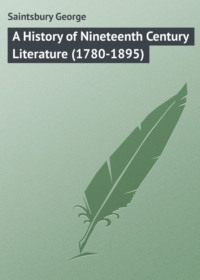 полная версия
полная версияA Short History of French Literature
Rutebœuf
Rutebœuf (whose name appears to be a nickname only) has been more fortunate than most of the poets of early France in leaving a considerable and varied work behind him, and in having it well and collectively edited74. Little or nothing, however, is known about him, except from allusions in his own verse. He was probably born about 1230; he was certainly married in 1260; there is no allusion in his poems to any event later than 1285. By birth he may have been either a Burgundian or a Parisian. His work which, as has been said, is not inconsiderable in volume, falls into three well-marked divisions in point of subject. The first consists of personal and of comic poems; the second of poems sometimes satirical, sometimes panegyrical, on public personages and events; the third, which is apparently with reason assigned to the latest period of his life, of devotional poems. In the first division La Pauvreté Rutebœuf, Le Mariage Rutebœuf, etc., are complaints of his woeful condition; complaints, however, in which there is nearly as much satire as appeal. Others, such as Renart le Bestourné, Le Dit des Cordeliers, Frère Denise, Le Dit de l'Erberie, are poems of the Fabliau kind. In all these there are many lively strokes of satire, and not a little of the reckless gaiety, chequered here and there with deeper feeling, which has always been a characteristic of a certain number of French poets. Rutebœuf's sarcasm is especially directed towards the monastic orders. The second class of poems, which is numerous, displays a more elevated strain of thought. Many of these poems are complaintes or elaborate elegies (often composed on commission) for distinguished persons, such as Geoffroy de Sargines and Guillaume de Saint Amour. Others, such as the Complainte d'Outremer, the Complainte de Constantinople, the Dit de la Voie de Tunes, the Débat du Croisé et du Décroisé, are comments on the politics and history of the time, for the most part strongly in favour of the crusading spirit, and reproaching the nobility of France with their degeneracy. 'Mort sont Ogier et Charlemagne' is an often-quoted exclamation of Rutebœuf in this sense. The third class includes La Mort Rutebœuf, otherwise La Repentance Rutebœuf, La Voie de Paradis, various poems to the Virgin, the lives of St. Mary of Egypt and St. Elizabeth of Hungary, and the miracle play of Théophile. Rutebœuf's favourite metres are either the continuous octosyllabic couplet, or else a stanza composed of an octosyllabic couplet and a line of four syllables, the termination of the latter being caught up by the succeeding couplet. In this the Mariage is written, of which a specimen may be given: —
En l'an de l'incarnacïon,VIII jors aprés la nascïonJhesu qui soufri passïon,en l'an soissante,qu'arbres n'a foille, oisel ne chante,fis je toute la rien dolanteque de cuer m'aime:nis li musarz musart me claime.or puis filer, qu'il me faut traime;mult ai a faire.deus ne fist cuer tant de pute aire,tant li aie fait de contrairene de martire,s'il en mon martire se mire,qui ne doie de bon cuer dire'je te claim cuite.'envoier un home en Egypte,ceste dolor est plus petiteque n'est la moie;je n'en puis mais se je m'esmoie.l'en dit que fous qui ne foloiepert sa saison:sui je marïez sanz raison?or n'ai ne borde ne maison.encor plus fort:por plus doner de reconforta ceus qui me heent de mort,tel fame ai priseque nus fors moi n'aime ne prise,et s'estoit povre et entreprise,quant je la pris.a ci marïage de pris,c'or sui povres et entreprisausi comme ele,et si n'est pas gente ne bele.cinquante anz a en s'escuële,s'est maigre et seche:n'ai pas paor qu'ele me treche.despuis que fu nez en la grechedeus de Marie,ne fu mais tele espouserie.je sui toz plains d'envoiserie:bien pert a l'uevre.Though he has less of the 'lyrical cry' than some others, Rutebœuf is perhaps the most vigorous poet of his time.
Lais. Marie de France.
There is one division of early poetry which may also be noticed under this head, though it is sometimes dealt with as a kind of miniature epic. This is the lai, a term which is used in old French poetry with two different significations. The Trouvères of the thirteenth and fourteenth centuries made of it a regular lyrical form. But the most famous of its examples, those which now pass under the name of Marie de France, are narrative poems in octosyllabic verse and varying in length considerably. It is agreed that the term and the thing are of Breton origin; and the opinion which seems most probable is that the word originally had reference rather to the style of music with which the harper accompanied his verse, than to the measure, arrangement, or subject of the latter. As to Marie herself75, nothing is known about her with certainty. She lived in England in the reign of Henry III, and often gives English equivalents for her French words. The lais which we possess, written by her and attributed to her, are fourteen in number. They bear the titles of Gugemer, Equitan, Le Fresne, Le Bisclaveret, Lanval, Les Deux Amants, Ywenec, Le Laustic, Milun, Le Chaitivel, Le Chèvrefeuille, Eliduc, Graalent and L'Espine. Mr. O'Shaughnessy has paraphrased several of these in English76; they are all narrative in character. Their distinguishing features are fluent and melodious versification, pure and graceful language – among the purest and most graceful, though decidedly Norman in character, of the time – true poetical feeling, and a lively faculty of invention and description. After Marie there was a tendency to approximate the lai to the Provençal descort, and at last, as we have said, it acquired rules and a form quite alien from those of its earlier examples. There is a general though not a universal inclination to melancholy of subject in the early lays, a few of which are anonymous.
Note to Third Edition.– M. Gaston Paris has expressed some surprise at my remarks on metre (p. 63). This from so accomplished a scholar is a curious instance of the difficulty which Frenchmen seem to feel in appreciating quantity. To an English eye and ear which have been trained to classical prosody the trochaic rhythm of, for instance, the Pastourelle quoted on p. 65, is unmistakable, and there are anapaestic metres to be found here and there in early poems of the same kind. Indeed, all French poetry is easily scanned quantitatively, though the usual authorities protest against such scansion. Voltaire, it is said, took Turgot's hexameters for prose, and the significance of this is the same whether the mistake, as is probable, was mischievous or whether it was genuine.
CHAPTER VII
SERIOUS AND ALLEGORICAL POETRY
In consequence of the slowness with which prose was used for any regular literary purpose in France, verse continued to do duty for it until a comparatively late period in almost all departments of literature. By the very earliest years of the twelfth century, and probably much earlier (though we have no certain evidence of this latter fact), documents of all kinds began to be written in verse of various forms. Among the earliest serious verse that was written rank, as we might expect, verse chronicles. It was not till 1200 at soonest that long translations from the Latin in French prose were made, but such translations, and original works as well, were written in French verse long before.
Verse Chronicles.
The rhymed Chronicles were numerous, but, with rare exceptions, they cannot be said to be of any very great literary importance. Whether they were imitated directly from the Chansons de Gestes, or vice versa, is a question which, as it happens, can be settled without difficulty. For they are almost all in octosyllabic couplets, a metre certainly later than the assonanced decasyllabics of the earliest Chansons. The latter form and the somewhat later dodecasyllable or Alexandrine are rarely used for Verse Chronicles, the most remarkable exception being the spirited Combat des Trente77, which is however very late, and the Chronique de du Guesclin of the same date. There are earlier examples of history in Alexandrines (some are found in the twelfth century, such as the account of Henry the Second's Scotch Wars by Jordan Fantome, Chancellor of the diocese of Winchester), but they are not numerous or important. It is not unworthy of notice that the majority of the early Verse Chronicles are English or Anglo-Norman. The first of importance is that of Geoffrey Gaymar, whose Chronicle of English history was written about 1146. Gaymar was followed by a much better known writer, the Jerseyman Wace78, who not only, as has been mentioned, versified Geoffrey of Monmouth into the Brut79, but produced the important Roman de Rou80, giving the history of the Dukes of Normandy and of the Conquest of England. The date of the Brut is 1155, of the Rou 1160. This latter is the better of the two, though Wace was not a great poet. It consists chiefly of octosyllabics, with a curious insertion of Alexandrines in rhymed not assonanced laisses. Wace was followed by Benoist de Sainte-More, who extended his Chronicle of the Dukes of Normandy to more than forty thousand verses. The 'Life of St. Thomas' (Becket), by Garnier de Pont St. Maxence, also deserves notice, as does an anonymous poem on the English wars in Ireland. But the most interesting of this group is probably the history81 of William Marshal, Earl of Pembroke, who died in 1219 and who during his life played a great part in England. It abounds in passages of historical interest and literary value. During the thirteenth and fourteenth centuries, the practice of writing history in verse gradually died out, yet some of the most important examples date from this time. Such are the Chronicles of Philippe Mouskès82, a Fleming, in more than thirty thousand verses, extending from the Siege of Troy to the year 1243. Mouskès is of some importance in literary history, because of the great extent to which he has drawn on the Chansons de Gestes for his information. In 1304 Guillaume Guiart, a native of Orleans, wrote in twelve thousand verses a Chronicle of the thirteenth century, including a few years earlier and later. There are a large number of other Verse Chronicles, but few of them are of much importance historically, and fewer still of any literary interest.
History, however, was by no means the only serious subject which took this incongruous form in the middle ages. The amount of miscellaneous verse written during the period between the end of the eleventh and the beginning of the fifteenth century is indeed enormous. Only a very small portion of it has ever been printed, and the mere summary description of the manuscripts which contain it is as yet far from complete. If it be said generally that, during the greater part of these three hundred years, the first impulse of any one who wished to write, no matter on what subject, was to write in verse, and that the popular notion of the want of literary tastes in the middle ages is utterly mistaken, some idea may be formed of the vast extent of literature, poetical in form, which was then produced. Much no doubt of this literature is not in the least worthy of detailed notice; much, whether worthy or not, must from mere considerations of space and proportion remain unnoticed here. What is possible, is to indicate briefly the chief forms, authors, and subjects, which fall under the heading of this chapter, and to give a somewhat detailed account of the great serious poem of mediæval France, the Roman de la Rose. Peculiarities of metre and so forth will be indicated where it is necessary, but it may be said generally that the great mass of this literature is in octosyllabic couplets.
Miscellaneous Satirical Verse.
It has already been observed in discussing the Fabliaux that the first enquirers into old French literature were led to include a very miscellaneous assortment of poems under that head; and it may now be added that this miscellaneous assortment with much else constitutes the farrago of the present chapter. The two great poems of the Roman du Renart and the Roman de la Rose stand as representatives of the more or less serious poetry of the time, and everything else may be said to be included between them. Beginning nearest to the Roman du Renart and its kindred Fabliaux, we find a vast number of half-satirical styles of poetry, many, if not most of them, known (according to what has been noted in the preface as characteristic of mediaeval literature) by distinctive form-names. Of these dits and débats have already been noticed, but it is not easy to give a notion of the number of the existing examples, or of the extraordinary diversity of subjects to which both, and especially the dits, extend. Perhaps some estimate may be formed from the fact that the dits of three Flemish poets alone, Baudouin de Condé, Jean de Condé, and Watriquet de Couvin, fill four stout octavo volumes83. The subjects of these and of the large number of dits composed by other writers and anonymous are almost innumerable. The earliest are for the most part simple enumerations of the names of streets, of street cries, of guilds, of coins, and such-like things. By degrees they become more definitely didactic, and at last allegorical moralising masters them as it does almost every other kind of poetry in the fourteenth century. The débat, sometimes called dispute, or bataille, is an easily understood variety of the dit. Rutebœuf's principal débat has been named; another in a less serious spirit is that between Charlot et le Barbier. There is a Bataille des Vins, a Bataille de Caréme et de Charnage, a Débat de l'Hiver et l'Été, etc., etc. Another name much used for half-satirical, half-didactic verse was that of Bible, of which the most famous (probably because it was the first known) is that of Guyot de Provins, – a violent onslaught on the powers that were in Church and State by a discontented monk. An extract from it will illustrate this division of the subject as well as anything else: —
Des fisicïens me merveil:de lor huevre et de lor conseilrai ge certes mont grant merveille,nule vie ne s'apareillea la lor, trop par est diverseet sor totes autres perverse.bien les nomme li communs nons;mais je ne cuit qu'i ne soit honsqui ne les doie mont douter.il ne voudroient ja trovernul home sanz aucun mehaing.maint oingnement font e maint baingou il n'a ne senz ne raison,cil eschape d'orde prisonqui de lor mains puet eschaper.qui bien set mentir et guileret faire noble contenance,tout ont trové fors la crëanceque les genz ont lor fait a bien.tiex mil se font fisicïenqui n'en sevent voir nes que gié.li plus maistre sont mont changiéde grant ennui, n'il n'est mestiersdont il soit tant de mençongiers.il ocïent mont de la gent:ja n'ont ne ami ne parentque il volsissent trover sain;de ce resont il trop vilain.mont a d'ordure en ces lïens.qui en main a fisicïens,se met par els. il m'ont ëuentre lor mains: onques ne fu,ce cuit, nule plus orde vie.je n'aim mie lor compaignie,si m'aït dex, qant je sui sains:honiz est qui chiet en lor mains.par foi, qant je malades fui,moi covint soffrir lor ennui.Testaments of the satirical kind, chiefly noteworthy for the brilliant use which Villon made of the tradition of composing them, resveries and fatrasies (nonsense poems with a more or less satirical drift), parodies of the offices of the Church, of its sermons, of the miracle plays, are the chief remaining divisions of the poetry which, under a light and scoffing envelope, conceals a serious purpose.
Didactic verse. Philippe de Thaun.
Such things have at all times been composed in verse, and the reason is sufficiently obvious. In the first place, the intention of the writers is to a certain extent masked, and in the second, the reader's attention is attracted. But the middle ages by no means confined the use of verse to such cases. Downright instruction was, as often as not, the object of the verse writer in those days. The earliest, and as such the most curious of didactic poems, are those of Philippe de Thaun, an Englishman of Norman extraction, who wrote in the first quarter of the twelfth century. His two works are a Comput, or Chronological Treatise, dedicated to an uncle of his, who was chaplain to Hugh Bigod, Earl of Norfolk, and a Bestiary, or Zoological Catalogue, dedicated to Adela of Louvain, the wife of Henry the First. Written before the vogue of the versified Arthurian Romances had consecrated the octosyllable, these poems are in couplets of six syllables. Their great age, and to a certain extent their literary merit, deserve an extract: —
Monosceros est beste,un corn ad en la teste,pur çeo ad si a nun.de buc ele ad façun.par pucele eat prise,or oëz en quel guise,quant hom le volt caceret prendre et enginner,si vent horn al orestu sis repaires est;la met une pucelehors de sein sa mamele,e par odurementmonosceros la sent;dune vent a la pucele,si baiset sa mamele,en sun devant se dort,issi vent a sa mort;li hom survent atant,ki l'ocit en dormant,u trestut vif le prent,si fait puis sun talent.grant chose signefie,ne larei nel vus die.Monosceros griu est,en franceis un-corn est:beste de tel baillieJhesu Crist signefie;un deu est e serate fud e parmaindrat;en la virgine se mist,e pur hom charn i prist,e pur virginited,pur mustrer casteed,a virgine se parute virgine le conceut.virgine est e serate tuz jurz parmaindrat.ores oëz brefmentle signefïement.Ceste beste en verténus signefie dé;la virgine signefie,sacez, sancte Marie;par sa mamele ententsancte eglise ensement;e puis par le baiserçeo deit signefïer,que hom quant il se dorten semblance est de mort:dés cum home dormi,ki en cruiz mort sufri,ert sa destructïunnostre redemptïun,e sun traveillementnostre reposement.si deceut dés dïablepar semblant cuvenable;anme e cors sunt un,issi fud dés et hum,e içeo signefiebeste de tel baillie.Bestiaries and Computs (the French title of the Chronologies) were for some time the favourites with didactic verse writers, but before long the whole encyclopædia, as it was then understood, was turned into verse. Astrology, hunting, geography, law, medicine, history, the art of war, all had their treatises; and latterly Trésors, or complete popular educators, as they would be called nowadays, were composed, the best-known of which is that of Walter of Metz in 1245.
Moral and Theological verse.
All, or almost all, these works, written as they were in an age sincerely pious, if somewhat grotesque in its piety, and theoretically moral, if somewhat loose in its practice, contained not only abundant moralising, but also more or less theology of the mystical kind. It would therefore have been strange if ethics and theology themselves had wanted special exponents in verse. Before the middle of the twelfth century Samson of Nanteuil (again an Englishman by residence) had versified the Proverbs of Solomon, and in the latter half of the same century vernacular lives of the saints begin to be numerous. Perhaps the most popular of these was the legend of Barlaam and Josaphat, of which the fullest poetical form has been left us by an English trouvère of the thirteenth century named Chardry, by whom we have also a verse rendering of the 'Seven Sleepers,' and some other poems84. Somewhat earlier, Hermann of Valenciennes was a fertile author of this sort of work, composing a great Bible de Sapience or versification of the Old Testament, and a large number of lives of saints. Of books of Eastern origin, one of the most important was the Castoiement d'un Père à son Fils, which comes from the Panchatantra, though not directly. The translated work had great vogue, and set the example of other Castoiements or warnings. The monk Helinand at the end of the twelfth century composed a poem on 'Death,' and a vast number of similar poems might be mentioned. The commonest perhaps of all is a dialogue Des trois Morts et des trois Vifs, which exists in an astonishing number of variants. Gradually the tone of all this work becomes more and more allegorical. Dreams, Mirrors, Castles, such as the 'Castle of Seven Flowers,' a poem on the virtues, make their appearance.
Allegorical verse.
The Roman de la Rose.
The question of the origin of this habit of allegorising and personification is one which has been often incidentally discussed by literary historians, but which has never been exhaustively treated. It is certain that, at a very early period in the middle ages, it makes its appearance, though it is not in full flourishing until the thirteenth century. It seems to have been a reflection in light literature of the same attitude of mind which led to the development of the scholastic philosophy, and, as in the case of that philosophy, Byzantine and Eastern influences may have been at work. Certain it is that in some of the later Greek romances85, something very like the imagery of the Roman de la Rose is discoverable. Perhaps, however, we need not look further than to the natural result of leisure, mental activity, and literary skill, working upon a very small stock of positive knowledge, and restrained by circumstances within a very narrow range of employment. However this may be, the allegorising habit manifests itself recognisably enough in French literature towards the close of the twelfth century. In the Méraugis de Portlesguez of Raoul de Houdenc, the passion for arguing out abstract questions of lovelore is exemplified, and in the Roman des Eles of the same author the knightly virtues are definitely personified, or at least allegorised. At the same time some at all events of the Troubadours, especially Peire Wilhem, carried the practice yet further. Merci, Pudeur, Loyauté, are introduced by that poet as persons whom he met as he rode on his travels. In Thibaut de Champagne a still further advance was made. The representative poem of this allegorical literature, and moreover one of the most remarkable compositions furnished by the mediaeval period in France, is the Roman de la Rose86. It is doubtful whether any other poem of such a length has ever attained a popularity so wide and so enduring. The Roman de la Rose extends to more than twenty thousand lines, and is written in a very peculiar style; yet it maintained its vogue, not merely in France but throughout Europe, for nearly three hundred years from the date of its commencement, and for more than two hundred from that of its conclusion. The history of the composition of the poem is singular. It was begun by William of Lorris, of whom little or nothing is known, but whose work must, so far as it is easy to make out, have been done before 1240, and is sometimes fixed at 1237. This portion extends to 4670 lines, and ends quite abruptly. About forty years later, Jean de Meung, or Clopinel, afterwards one of Philippe le Bel's paid men of letters, continued it without preface, taking up William of Lorris' cue, and extended it to 22,817 verses, preserving the metre and some of the personages, but entirely altering the spirit of the treatment. The importance of the poem requires that such brief analysis as space will allow shall be given here. Its general import is sufficiently indicated by the heading, —
Ci est le Rommant de la RoseOù l'art d'amors est tote enclose;though the rage for allegory induced its readers to moralise even its allegorical character, and to indulge in various far-fetched explanations of it. In the twentieth year of his age, the author says, he fell asleep and dreamed a dream. He had left the city on a fair May morning, and walked abroad till he came to a garden fenced in with a high wall. On the wall were portrayed figures, Hatred, Félonnie, Villonie, Covetousness, Avarice, Envy, Sadness, Old Age, Papelardie (Hypocrisy), Poverty – all of which are described at length. He strives to enter in, and at last finds a barred wicket at which he is admitted by Dame Oiseuse (Leisure), who tells him that Déduit (Delight) and his company are within. He finds the company dancing and singing, Dame Liesse (Enjoyment) being the chief songstress, while Courtesy greets him and invites him to take part in the festival. The god of love himself is then described, with many of his suite – Beauty, Riches, etc. A further description of the garden leads to the fountain of Narcissus, whose story is told at length. By this the author, who is thenceforth called the lover, sees and covets a rosebud. But thorns and thistles bar his way to it, and the god of love pierces him with his arrows. He does homage to the god, who accepts his service, and addresses a long discourse to him on his future duties and conduct. The prospect somewhat alarms him, when a new personage, Bel Acueil (Gracious Reception), comes up and tenders his services to the lover, the god having disappeared. Almost immediately, however, Dangier87 makes his appearance, and drives both the lover and Bel Acueil out of the garden. As the former is bewailing his fate, Reason appears and remonstrates with him. He persists in his desire, and parleys with Dangier, both directly and by ambassadors, so that in the end he is brought back by Bel Acueil into the garden and allowed to see but not to touch the rose. Venus comes to his aid, and he is further allowed to kiss it. At this, however, Shame, Jealousy, and other evil agents reproach Dangier. Bel Acueil is immured in a tower, and the lover is once more driven forth.




